


Introduction
Executive Letters

Our collective narrative of the 20th century was significantly shaped by German businesses, which were pioneers in creating the lifestyle and conveniences enjoyed worldwide today.
Meeting with some of the most influential female executives during the first PULSE Women Economic Summit last September was incredibly enlightening.

Among other things, we questioned the vision for Germany, and it became clear that we all have a more or less clear idea of the vision and strategy for our own companies. But what is the agenda for our country? How do we want to meet the many challenges we face as a society? The answers to these questions were less clearly defined.
At the same time, there was a desire among all of us to play an active role in positively shaping the future of Germany and Europe. This desire has persisted and was evident during events and discussions we’ve held since. What does a vision look like that serves as kind of a North Star; and how can we move decisively from talk to action?
These future scenarios developed by Amy Webb’s Future Today Institute with the support of the PULSE Women Economic Network, other leading executives from the German economy and the Handelsblatt Research Institute are intended get us closer to taking action.
I confess in the beginning I was a little skeptical that any concrete scenarios could be developed for Germany at all. Now, I am impressed by the results and the potential we have before us. These scenarios detail the opportunities that are possible if we support innovation and technology—and our role in it. The scenarios show once again that our future has not been written yet. It is in our hands to continue the story!
Andrea Wasmuth
Chairman of the Board of Directors
Handelsblatt Media Group
Author
Christina von Messling leads our European client portfolio and our Life Sciences practice area at Future Today Institute. She is renowned for her expertise in strategic foresight and an unparalleled ability to navigate complex industry landscapes.

With a career spanning over two decades, she has guided multinational corporations through transformative strategies, leveraging her deep understanding of market dynamics and future trends.
Christina’s diverse experience across sectors enables her to craft visionary scenarios and strategies, driving sustainable growth and innovation for clients worldwide. Having split her time between Europe, the UK, Brazil, and the US, she combines a global perspective with in-depth, holistic expertise of the main drivers of change: technology, geopolitical, economic, and societal developments. She has advised leading pharmaceutical and health care companies, as well as beauty, entertainment, media, and retail brands.
Christina is a coach in the strategic foresight MBA course at the NYU Stern School of Business. She holds a Masters in Law from the Freie Universität Berlin, where she graduated within the top 10% of the nation. She works from offices in New York City, Berlin, and London.
Christina von Messling
Head of Europe at Future Today Institute
Purpose of Scenarios
The scenarios you are about to read describe how Germany’s economic landscape could look like in the year 2035, based on decisions that are made today. They vividly illustrate the mid- and long-term consequences of (in)actions, particularly from corporate leaders and politicians, on Germany’s business landscape.
They are not economic or political forecasts.
They are not meant to describe the most likely development.
The purpose of the scenarios is to provide a vision the country can rally behind, and to incite immediate action toward that vision.
Business leaders need to decide how they will respond to the outlined opportunities and challenges.
To proactively create a preferred future and not merely respond to a reality someone else has defined, it is imperative to look beyond the time horizon of the strategic planning cycle. A clear understanding of not-yet-realized opportunities, threats, and evolution of your company is necessary to build resilience and ensure success in this rapidly changing world.
Ultimately, the aim is to ensure that Germany continues to be a global leader of innovation.
Executive Summary
Germany Faces Diverse Challenges
Geopolitical, economic, and societal headwinds meet unique internal challenges of key stakeholder groups.
Germany 2024
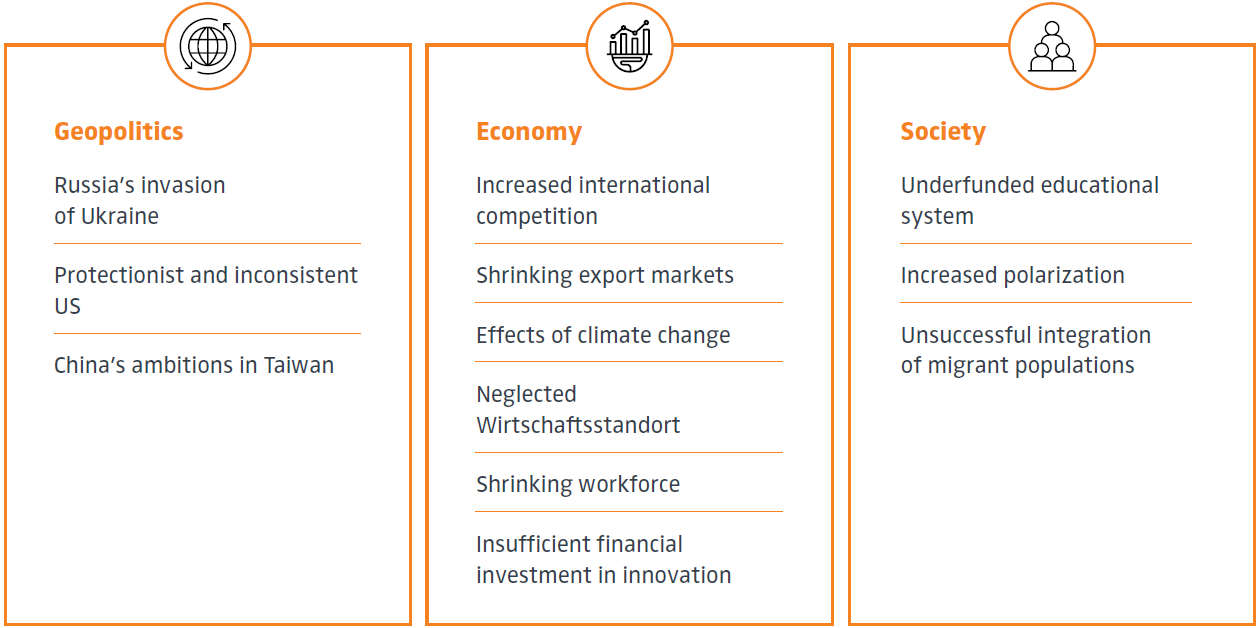
Stakeholders

Challenges Restrict Full Use of Germany's Strengths
The diverse set of challenges prevents Germany from fully leveraging its economic and innovative strengths.
Germany's Strengths

1. Hidden champions of Germany’s Mittelstand are highly specialized, lesser-known companies leading their niche markets globally.
Will Germany Choose Opportunity or the Status Quo?
Germany is at a crossroads.
Action alone is not enough to future-proof Germany’s success. Fragmented efforts with the aim of protecting the status quo will, in fact, lead to a “death by a thousand paper cuts.”
The country’s government and leaders will need to take focused steps to grasp the opportunities that present themselves. A series of thoroughly considered, incremental steps will build a solid foundation for Germany to not only ride but lead the wave of innovation over the next decade and beyond.
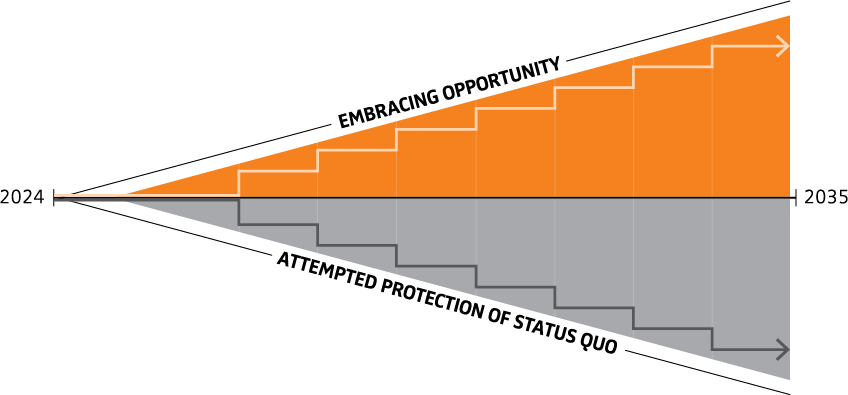
Executive Summary Scenario 1: Embracing Opportunity
In the first scenario, government and business leaders took focused action that led to fundamental changes in the economic landscape and society.
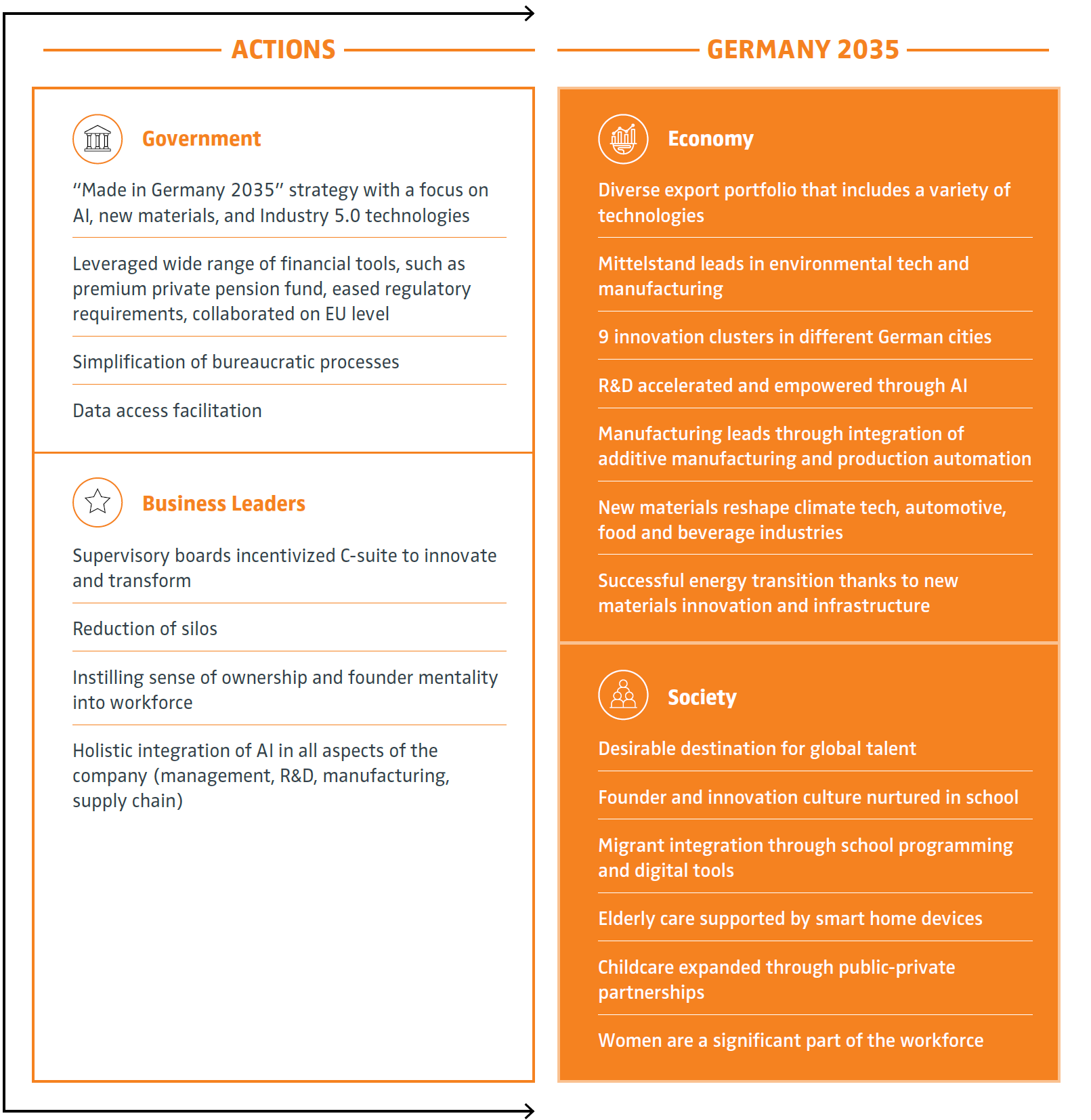
Vision for Germany
If leaders take focused, decisive action today to embrace opportunities and fully leverage the country’s strengths, Germany will continue to be a global leader in innovation:
Dynamic economy fueled by technological innovation and sectoral diversity
The strategic application of AI across sectors streamlines operations and dramatically speeds up research and development, futureproofing Germany’s economic leadership and diversity.Architect of advanced manufacturing Germany’s manufacturing landscape is powered by the strategic implementation of automation.
The nation excels in designing new materials at scale by leveraging synthetic biology, and additive manufacturing enables rapid, cost-effective production, minimizing reliance on imports and maximizing manufacturing flexibility.Leader in ecological integrity and renewable innovations
Germany is on the forefront of climate innovation. Investments in renewable energy research, collaboration with leading scientific institutions, and supportive policies encourage the adoption of ecofriendly practices across all sectors. This holistic approach enables Germany to drive international standards in sustainability and climate resilience.Global epicenter of innovation
Corporate governance incentivizes performance, risk-taking, and trial-and-error processes, fostering a culture of continuous improvement. Collaboration happens within companies, across departments, and externally with other private, public, and academic stakeholders in the numerous innovation clusters. The elaborate startup ecosystem makes Germany a desirable hub for global talent.Inclusive and unified society Germany’s strategic focus on education and health care has fostered an inclusive society.
AI-enhanced learning supports a diverse student population, and educational reforms promote social cohesion. The integration of migrants and the provision of new technologies reflect a commitment to building a unified society that values diversity, inclusion, and the well-being of all its members.
Opportunities
If leaders take focused, decisive action today to embrace opportunities and fully leverage the country’s strengths, Germany will continue to be a global leader in innovation:
Approach business models and workforce development with a fresh perspective
What led to success in the past will not necessarily yield success tomorrow. Germany has an incredible set of strengths: strong engineering and manufacturing prowess, respected research institutions, and a vibrant Mittelstand whose “hidden champions” are global leaders in their respective fields. However, the current breadth, depth, and speed of technological innovation and a shifting geopolitical landscape with new competitors emerging require a fundamental shift in how these strengths are leveraged. To activate the resources desperately needed for Germany to lead in the world of tomorrow, business leaders should create an environment in which their workforce realizes the full scope of the current opportunity and their decisive role in determining the outcome.Develop the foundational ecosystem for innovation
Expand data acquisition and establish a unified data structure. The innovations in AI, synthetic biology, and Industry 5.0 are enabling technologies that change the base layer of business: products and services, operations, processes, manufacturing, and the wider supply chain. But they all require structured data that can be ingested into the respective ecosystem. Determining what data is needed, installing necessary mechanisms for collection, labeling and storing this data, and managing accessibility can be a daunting feat, yet is imperative for successful leveraging of these technologies.
Extract knowledge from novel sources to drive growth
Find new partners that can provide the necessary expertise to think differently about the business. Germany can only win if the country as a whole has a vibrant and dense innovation ecosystem. From research, to all stages of the startup process, to connection and mentorship from large corporations and
the government, all stakeholders benefit from close collaboration to share resources, best practices, and expertise. This fluid exchange provides broader access and guidance to innovation, by including those who have limited resources. And it attracts international talent that is looking for diverse, supportive environments for diverging discussions, idea inspiration, and realization. Forging these relationships to all stakeholders within the innovation ecosystem will not only increase the resilience of the business but also ensure Germany’s status as a global leader in innovation.
Executive Summary Scenario 2: Attempting to Protect the Status Quo
In the second scenario, government and business leaders’ aim to protect the status quo by only taking actions with limited ambition ultimately led to the slow decline of Germany as an economic power.
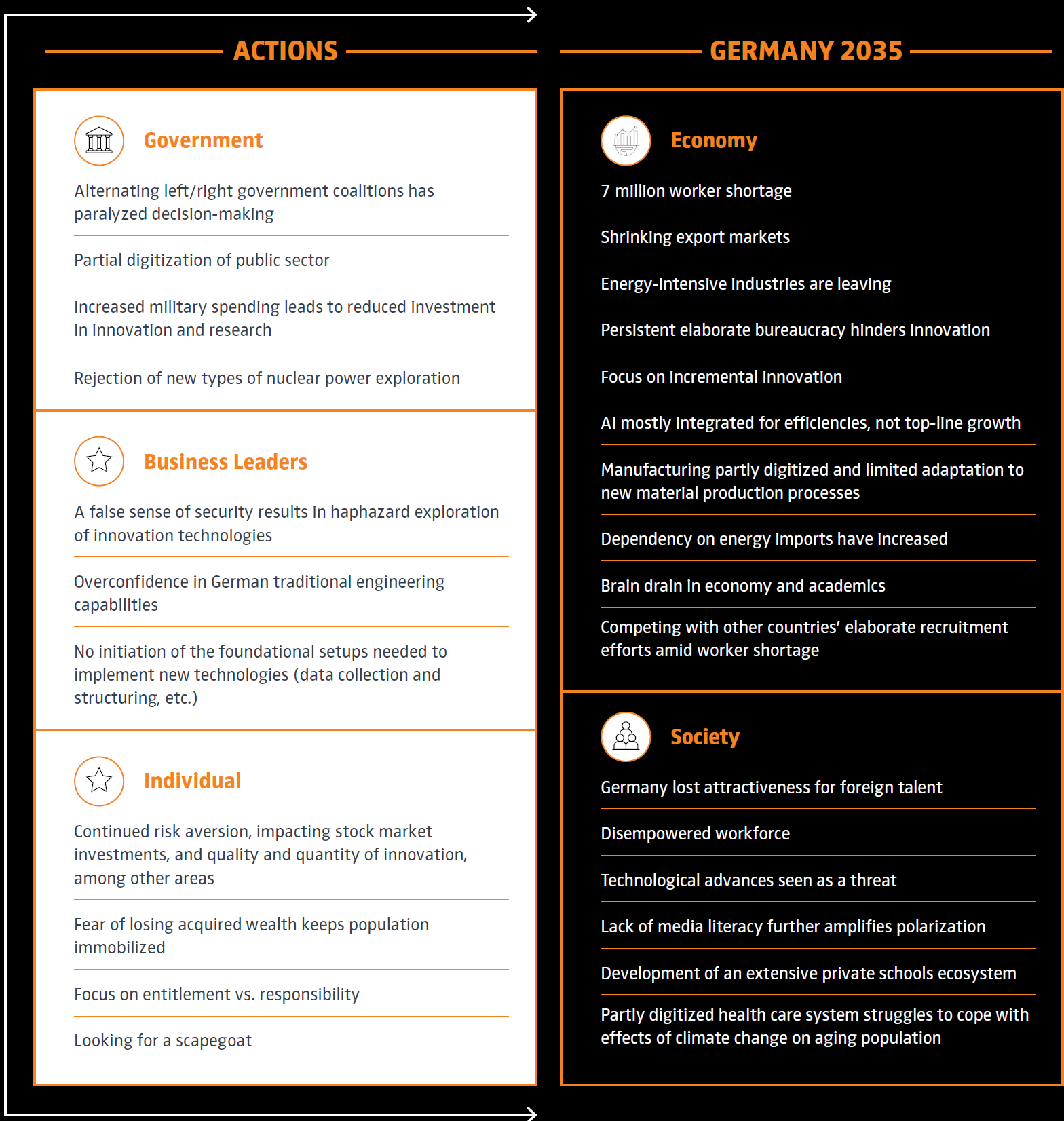
Realities in 2035
Leaders’ haphazard action and limited ambition to protect the status quo and resulted in a slow but steady decline:
Workforce and innovation challenges
Germany faces a critical shortage of 7 million skilled workers, significantly impacting the economy. This deficit, coupled with a reluctance to sufficiently invest in innovation and economic activities, has led to Germany transitioning from a leader to a midfield position in the global innovation league. The ambitious bet on becoming the European center for chip manufacturing has not paid off, further restraining Germany’s technological advancement.
Government and digital transformation struggles
Efforts to digitalize government services and incorporate AI and large language models (LLMs) have resulted in a patchwork system that has introduced more red tape and inefficiencies. This has frustrated businesses and led some to relocate their innovation efforts to more supportive environments. Additionally, the allure of Germany as a premier destination for global talent is waning due to these inefficiencies and a societal shift toward populism.
Declining research and manufacturing capabilities
Government-funded research capabilities have declined due to budget cuts, affecting institutions like Max Planck and Fraunhofer-Gesellschaft. Privately funded research is confined to entities in robust financial positions, focusing on enhancing existing product lines rather than exploring groundbreaking innovations. In manufacturing, companies face challenges from rising labor costs and a shrinking pool of skilled workers, limiting the potential of digitalization and automation technologies.
Energy transition and environmental challenges
The attempted shift to sustainable energy sources is hampered by bureaucratic obstacles and a lack of innovative financial mechanisms. Germany’s dependence on energy imports and efforts to phase out lignite production have resulted in volatile energy prices and occasional shortages, compounded by extreme weather events damaging infrastructure and disrupting goods transport.
Cultural and societal shifts
The German workforce is increasingly disempowered, perceiving technological advancements more as threats than opportunities. A culture of minimal effort has developed, where maximizing benefits from employers is seen as a victory. Meanwhile, the educational system struggles to integrate the migrant population and stay competitive globally, further exacerbating the country’s downward innovation trajectory and economic vitality.
Threats
If leaders take focused, decisive action today to embrace opportunities and fully leverage the country’s strengths, Germany will continue to be a global leader in innovation:
Past successes lull leaders into a false sense of security
It is imperative for business leaders to analyze how they might be disrupted by new and old competitors. Germany’s manufacturing and engineering expertise has been in demand globally over the past decades and secured the country’s place as one of the world’s strongest economies. However, its major industries are at risk of being toppled off their perch. Take China’s advances in the electric vehicle sector: What was once thought to be an insurmountable barrier to entry no longer exists, and customer needs are shifting from machinery to software. A false sense of security now will limit or completely negate options down the road, and will make it impossible to implement more time-consuming, yet necessary, measures to take full advantage of technological innovation.
Haphazard innovation integration affects future progress
Innovation initiatives should either solve an existing challenge or create new opportunities. While it’s tempting to jump on the bandwagon of the latest buzzword and “do something with AI,” for example, the costs can be high: not just in regards to financial resources but also in regards to loss of trust and frustration within the workforce, which will make it more difficult to get buy-in for subsequent changes. The best way forward might not be AI (or another technology). But this type of measured, thoughtful approach to innovation will gain employees’ trust and lay the groundwork for potentially more significant changes.
A disengaged workforce diminishes future competitiveness
Ensure that the workforce is optimally trained and motivated to go beyond their standard job responsibilities. The projected labor shortage over the next 10 years is significant, and will (often, already is) be felt throughout all industries. In addition to the intense competition for talent will be the need to leverage each individual’s expertise to the fullest. Look beyond a person’s specific job description to a wider range of skills such as identifying areas of improvement and grasping new opportunities that present themselves. Having a workforce that is disconnected from the company vision, focused on minimal performance for maximum gain, and does not feel seen or heard will be detrimental to business operations.Scenarios
Reading Guide
These scenarios have been written for you, in particular, to prepare you and your organization to succeed in the future. As you read them, keep the following considerations in mind to move to action:
How do the described developments affect my industry?
What are secondary implications that could affect me in unexpected ways?
Scenario 1: Embracing Opportunity
Introduction
By 2035, Germany’s export portfolio has diversified. Climate, health, and information technologies now own significant export shares, highlighting Germany’s embrace of digital innovation. AI—specifically large action models (LAMs) and the evolution of large language models (LLMs)—is the foundational layer of all public and private activity. Its full embrace has enabled innovation that firmly keeps Germany as a global leader in its core competencies: auto, manufacturing, chemicals, as well as key technological industries. AI also streamlined business operations throughout the entire supply chain. Research and development is now happening at amplified speeds measured in days versus the mid- 2020s when product development took months or years.
Manufacturing is largely automated and runs smoothly, thanks to predictive maintenance. In addition to the strength of Germany’s largest players,Mittelstand’s “hidden champions” have maintained their stronghold, particularly in the production of the manifold new materials.
These successes were strongly driven by the government’s “Made in Germany 2035” agenda, a response to escalating economic and geopolitical challenges in the mid-2020s. The plan focused on enabling the development and implementation of technologies that would future-proof a wide range of industries: AI, synthetic biology, and automation in industrial processes. Business leaders were incentivized by supervisory boards that created innovation metrics: Collaboration, trial-and-error processes, and risk-taking were rewarded. Internally, a workforce developed that was empowered to make a difference in the bottom line of the business. Externally, the innovation mindset of business leaders led to a deep integration of companies in regional innovation clusters, seeking partnerships with universities, startups, and the public sector. Germany’s leadership role on the European continent has manifested through targeted collaboration with foreign innovation ecosystems and the development of a uniting platform to foster a constant exchange of the latest developments.
Technology-Driven Industry Developments
Implementation of AI Enables Advancements Across Sectors
By 2035, business operations in multiple industries have undergone a profound transformation driven by the implementation of sophisticated AI tools.
Supported by LLMs in the late 2020s and by LAMs today, the wave of change has enabled significantly reduced overhead, increased speed, improved efficiency through reduced paperwork, and streamlined operations.
In the mid-2020s, businesses started fully utilizing their vast amounts of structured data by incorporating LLMs into their processes. This move toward efficiency was further bolstered by the German government’s development of a public LLM dedicated to managing public data during the same period. The governmental LLM was designed to work in harmony with corporate LLMs, enhancing logistical, reporting, and bureaucratic data management.
Additionally, the emergence of specialized small language models (SLMs) brought about improvements in specific areas like legal support or design by tapping into company-specific resources such as production data. This integration facilitated streamlined decision-making across various sectors.
Then, in the late 2020s, the emergence of LAMs, propelled by the demand for AI systems capable of real-time interaction with the world, significantly outperformed the primarily text-based, historical data-focused LLMs. With the merging of digital and physical realms spurred by spatial computing devices like Apple’s Vision Pro and Humane’s AI Pin, the inadequacies of training AI solely on internet-based data became clear. LAMs, skilled in interpreting actions and intentions, can predict and guide future actions, transforming task execution in multiple industries.
Germany’s strategic adoption of AI, especially through the integration of LAMs, has led to unprecedented advancements across its vital sectors. In the automotive industry, German companies have redefined the standards for modern mobility, by employing LAMs to equip vehicles with the capability for real-time navigational judgments. The pharmaceutical industry witnessed leading companies like Merck and Sanofi leveraging LAMs to accelerate research and innovation by analyzing vast datasets to predict outcomes effectively. Moreover, manufacturing and technology giants, including Zeiss and BASF, have embraced LAMs to enhance their operations, achieving unparalleled accuracy in production and surgical procedures. This commitment to pioneering advanced models has significantly advanced Germany’s industries, underscoring AI’s revolutionary impact on national development.
Advanced Data Techniques Drive Accelerated Research
Germany’s innovation landscape has been transformed by the combined impact of AI and synthetic biology. As scientists redesign and develop new systems found in nature, what used to take months or even years in research and drug development now unfolds in mere weeks and months.
A data-centric research ecosystem now forms the backbone of laboratories, where massive digital databases store extensive research data, patient outcomes where applicable, and genetic information. AI algorithms mine these databases to identify patterns and insights, significantly speeding up the identification of potential targets.
Thanks to AI, the rapid design of synthetic biological substances isn’t limited to pharma. Any industry that uses materials can benefit, and these substances are now available to laboratories around the country.
In the 2020s, it was already clear AI would have a groundbreaking impact on innovation capabilities, as shown at the time through DeepMind’s AlphaFold, which predicts structures of proteins and aids drug discovery, and GNoME, which grew the number of known stable materials almost tenfold. Since then, the accuracy of AI’s calculation has further increased the speed of innovation, and today, access to the technology has scaled. Now, it takes most research labs days and weeks to produce materials that once would have taken months and years.
The Germany of the 2020s, with its deep engineering and manufacturing know-how, laid the foundation for high-precision laboratory machine ecosystems, and German companies were early adopters. Today, fully autonomous laboratories synthesize promising candidates of new compounds, integrating robotics with machine learning. Conditions are optimized in real time and, in the case of pharma, tested in synthetic trials, simulating patient responses to new drugs based on comprehensive genetic and medical history datasets.
Synthetic Biology Transforms Energy, Automotive, and Food
This scaling of synthetic material development, initiated by Google’s DeepMind in the mid-2020s, was a complete game changer for businesses. Every industry could develop desired materials at extremely high speeds and low cost, providing a large amount of control over their supply chain. With this technology, situations like importing rare earths from China was no longer a necessity but a choice, since new materials could be developed closer to home.
While some nations struggled to adjust manufacturing processes to handle the new materials, Germany didn’t have this issue. Here, the country’s strong and nimble manufacturing capabilities once again aided a technology’s swift adoption, with no issues producing the needed machinery or adjusting processes that would be flexible enough to accommodate constantly changing materials.
AI-driven research has transformed the solar and building materials industry, leading to the development of bioengineered solar cell materials able to absorb a larger spectrum of light wavelengths; this allows them to extract more energy while slowing down deterioration of the cells, significantly enhancing solar energy efficiency and reducing costs. Now, buildings are constructed with smart, self-healing materials that are often grown, rather than manufactured.
Growers cultivate mycelium-based bricks in indoor facilities, and algae-infused panels adapt and change properties in response to environmental conditions. The advancements not only boost energy efficiency but also reduce carbon footprints, marking significant progress in sustainable construction and energy production.
In the automotive industry, battery innovation has benefited from synthetic biology. Rather than using traditional materials like cobalt—rare, sourced from unstable countries, and toxic—manufacturers can now use synthetically created organic materials that are stable, cheaper, smaller in size, and capable of storing more energy. When German automakers shifted to producing more affordable EV models to compete with China, the fast development of these custom synthetic materials and flexible manufacturing methods gave Germany a competitive advantage, and ushered in a recapturing of a market segment lost to the Chinese during the mid-2020s.
For food and beverage companies, precision fermentation processes led to the creation of high-quality, alcohol-free beers that match the taste and texture of their alcoholic counterparts.
Traditionally, nonalcoholic beers neither tasted nor smelled like “real” beer because halting the brewing process early to avoid creating alcohol also removed the hop aromas. The breakthrough, using synthetic yeast to contribute the hop aroma, broadened the market for nonalcoholic beverages and supported healthier lifestyle choices, very much in-vogue with the younger generations.
Synthetic biology is also aiding the dairy industry, with companies making traditional German cheeses like Allgäuer Emmentaler, Limburger, and Harzer with synthetic cow’s milk. The milk is produced by inserting casein-producing genes into yeast, which imitates the proteins found in real cow’s milk. After purification, these proteins are blended with fats and sugars from plants to create a milk-like product. They offer sustainable alternatives to dairy products, reducing the environmental impact of dairy farming and providing consumers with eco-friendly choices.
Additive Manufacturing and Automation Propel Manufacturing Forward
While previously a lack of data hindered a comprehensive understanding of factory operations, German companies have now addressed this critical gap. By installing sensors throughout their facilities in the 2020s, they now have detailed insight into every aspect of production. Companies benefit from digital twins, which are virtual models of the plant using sensor data that mirror processes in real time and forecast maintenance needs, enhancing efficiency.
The integration of data from LAMs directly into these digital twins further optimizes production processes, and this technological leap has enabled automation to replace workers and reduce production costs.
The Mittelstand embraced additive manufacturing early on, triggered by the broken supply chain caused by the pandemic. While at first they focused on prototyping and making spare parts, companies saw broader opportunities in industries experiencing major disruption in the 2020s, such as the medical, transportation, and automotive sectors.
Industries took note of the benefits of additive manufacturing, like increased flexibility in production and greater independence from supply chains disrupted by geopolitical tensions or climate change, and the technology soon found wide adoption. Business developed in two ways: Germany’s additive manufacturing machines were in high demand globally, and German manufacturing companies were able to accommodate the need for quick, and constantly changing, production cycles of evolving new materials.
Novel Energy Generation and Storage Technologies Help Achieve Net-Zero Goals
Germany’s push for a transition to net-zero emissions by 2045 has already made considerable progress, achieving a 55% reduction in emissions by 2030.
Reaching that milestone involved advancements in high-voltage infrastructure, novel energy storage technologies, nuclear reactor experimentation, and significant strides toward energy independence for residents—as well as collaboration among the government, energy providers, industry, and citizens.
High-voltage power lines now transport wind power from the windy north, including offshore in the North Sea, to the industrious south, despite some local opposition. This effort has been complemented by decentralized initiatives, reducing the need for extensive infrastructure expansion.
Significant advancements in energy storage technologies have aided this transition to renewables. Solid-state batteries, produced cheaply with synthetic materials, offer higher energy density, longer lifespan, and wider operating temperatures—and increasingly, Germany is able to synthetically manufacture the needed materials, like lithium metal, domestically. In addition, the country’s strong buildout of the hydrogen infrastructure in the late 2020s is supporting the use of renewable energies today. The excess electricity generated by wind and solar powers electrolyzers to produce hydrogen, which can be stored for extended periods in pressurized tanks or liquid form. This enables decentralized storage on a regional level and balances the grid through supplying renewable energy when the output is low. Once needed, the stored hydrogen can be converted back into electricity.
Motivated by a desire to stabilize the power grid and meet the rising energy demands driven by AI and other technologies, Germany is also exploring new nuclear reactor concepts, including modular designs and alternative coolants like molten salt and liquid metals. This move is also partly motivated by a desire to reduce reliance on France, where climate change impacts on nuclear plants have led to energy shortages, thus affecting Germany’s energy security.
On a local level, residents have achieved remarkable energy independence. Electric vehicles equipped with vehicle-to-home and vehicle-to-grid capabilities not only supply energy to households but also contribute stability to the local power grid as needed. The adoption of small bladeless wind turbines on rooftops and the installation of transparent perovskite solar cells over windows enhance the energy self-sufficiency of both urban and rural homes.
Increasingly, these homes are constructed using carbon neutral or negative building materials—such as sustainable concrete, green steel (benefiting from a developed hydrogen infrastructure), and engineered wood that traps carbon dioxide. This development significantly reduces the building’s overall carbon footprint, marking a critical step toward a sustainable and independent energy future, and tackling one of the early pain points in the energy transition.
Evolutions in Corporate Governance
Company Leadership and Culture Undergoes a Strategic Shift
The government’s financial and regulatory support, manifested through tax incentives, direct funding, and infrastructure investments, played a crucial role in the development, adoption, and scaling of technologies. However, the pivotal momentum originated from business leaders.
Supervisory boards came to several critical realizations. They acknowledged that Germany had relinquished its leadership in key industries, such as automotive and climate tech, and was on the brink of losing ground in other successful sectors, like pharma and health tech. Recognizing the urgency, they decided to propel change by leveraging Germany’s core competencies: unmatched performance and problem-solving capabilities. There was a clear need to cultivate a culture that not only embraces risk but also values the process of trial and error.
To enact this shift, members of the supervisory boards (Aufsichtsrat) made a strategic adjustment to the compensation structure of C-suite executives (Vorstand). They introduced innovation metrics that incorporated a tolerance for failure and bonuses for cross-departmental projects to encourage risk-taking, foster collaboration, and embrace a trial-and-error approach. They set goals for patent filings and the development of novel products, services, and business models, incentivizing executives to effectively delegate decision-making authority. They also gave rewards to those who implemented systems enabling employees at all levels to contribute ideas and feedback.
This comprehensive approach has not only revitalized innovation within companies but also positioned Germany to reclaim its stature in global industries.
Synergies in Germany’s Innovation Ecosystem Drive Growth
In Germany’s vibrant innovation ecosystem, companies are intricately woven into one of the country’s nine innovation hubs, which serve as collaborative networks of private, public, and academic stakeholders. The innovation clusters organically developed due to the location of company headquarters such as Merck in Frankfurt and Beiersdorf in Hamburg, combined with a high university density. Stuttgart stands out for its automotive innovation, driven by giants like Mercedes-Benz, Bosch, and Valeo, while Heidelberg and Mannheim are dominated by BASF, leading in chemistry and material sciences.
University incubators first fostered startup ecosystems in these locations; the hubs then scaled through public and private investment into accelerators and mentorship programs. Today, these clusters are widely recognized for their dominance in their respective specialties.
Early on, strategically directed government funding helped Germany establish itself not only as a quick adopter of innovative products and services but as a leading innovator. The impact on the country’s innovation landscape has been profound: The emergence of diverse and sophisticated products and services has drawn a wider range of international investors and significantly boosted Germany’s competitiveness on the global stage. As these innovation ecosystems have evolved and leadership has become more receptive to unconventional business ideas, companies increasingly pursue product innovations outside their primary area of business, viewing them as opportunities for investment or acquisition. This holistic approach has pushed Germany to the forefront of global innovation, where disruptive ideas are nurtured and can thrive.
Meanwhile, Germany’s esteemed traditional research institutions, such as the Max Planck, Leibniz, Helmholtz, and the Fraunhofer societies, support and mentor deep tech ventures. Access to the institutions’ cutting-edge research facilities enables startups to undertake sophisticated experiments and prototyping that would otherwise be out of reach. Assistance from the institutions’ industry experts accelerates commercialization, and the existing network of the Fraunhofer Society provides an entry point to the market.
This evolved ecosystem has encouraged most startups to remain in Germany rather than heading abroad, nurturing a robust domestic innovation landscape that continues to thrive and expand.
And it’s not just the companies that benefit. The rise of these innovation hubs have made the surrounding areas coveted living destinations, attracting both young Germans lured by promising job opportunities and international talent eager to engage with these dynamic ecosystems of founders, researchers, technologists, and creatives. Also playing a role are the EU’s regulatory frameworks, positioning the continent as the champion of ethical innovation. Within the EU, Germany’s open, diverse, and educated society, enriched by a deep cultural heritage and strong social values, further enhances its appeal.
Public-Private Collaboration Is Leveraged to Fight Climate Change
Energy providers and the German government have joined forces to combat the potential billions of dollars expected from climate change damages. They launched public-private partnerships and allowed energy projects to bundle together, enabling access to diverse financing tools for projects otherwise deemed too costly, especially those under $50 million.
The government supported these efforts with a suite of measures: offering tax incentives, easing regulations to lower capital requirements for credit eligibility, simplifying reporting for project owners, and serving as a primary guarantor to minimize banking risks. These initiatives accelerated the deployment of environmentally sustainable projects, marking a significant step toward mitigating climate change impacts and fostering a resilient future.
Governmental Actions
The Government Makes a Strategic Pivot Toward Innovation and Sustainability
In the mid-2020s, a series of escalating challenges tested Germany’s economic resilience, environmental strategies, and social cohesion. Heightened global competition, a loss of leadership in key industries like automotive, shrinking export markets, and an increasingly unfavorable domestic business environment were major issues, and these headwinds were compounded by a demographic dilemma: a population growing more frustrated and polarized, manifesting itself in a strengthening of right-wing movements.
In response to these multifaceted challenges, the German government devised a strategic plan akin to China’s “Made in China 2025,” which, ironically, had been inspired by Germany’s own “Industry 4.0” initiative. Dubbed “Made in Germany 2035,” the strategy aimed to future-proof the German economy and bolster the energy transition.
Rather than concentrating on specific industries alone, the focus was supporting foundational technologies capable of scaling innovation in a multitude of industries. The three technologies included new materials (with applications across climate, pharmaceuticals, automotive, and heavy industries), AI (as a cornerstone of future processes), and Industry 5.0 technologies, which enhance manufacturing flexibility, facilitate the production of newly developed materials, and streamline processes in the face of demographic challenges with a reduced workforce.
To activate this strategy, the government implemented several key measures to boost innovation financing. Officials created a State Fund dedicated to startups and innovative projects, and established a premium private pension fund that automatically invested a portion of salaries into the stock market. This latter approach was particularly novel as few Germans traditionally invested in stock, and it had the added benefit of increasing public engagement with equity investments and channeling more savings into the economy. Additionally, regulations were adjusted to allow pension funds and insurers to invest in riskier assets, while enhanced collaboration at the EU level aimed to finance later-stage innovation rounds. The government also streamlined bureaucratic processes for innovation approvals and improved access to data, particularly health data for research, among other reforms.
The Government Develops a Strategic Response to Demographic Challenges
Facing polarization on the one hand and the imperative to integrate migrant populations on the other, the German government launched a multifaceted strategy to enhance public services and foster inclusion.
The first step was to simplify bureaucratic processes through digitalization, making government services more accessible and efficient for everyone, including migrants. In the near term, this also meant facilitating the integration of foreign workers by simplifying work visa processes and recognizing international qualifications, directly addressing the skilled labor shortage.
But Germany also put a premium on enhancing and integrating the next generation of an international population. The government prioritized primary education reform, inspired by the Nordic model, to cultivate Germany’s intellectual resources from a young age. The strategy focused on early childhood development and language learning as a means to advance social integration, educational equity, and inclusion. By raising salaries and providing extra training for teachers, the government equipped educators to meet the needs of a more diverse student body. Expanding access to digital resources also supported personalized and at-home learning, ensuring that all students, regardless of background, could thrive.
Federal Investment Leads to Improvements in Education and Care
The German government’s investment in education and care has yielded significant benefits.
In primary education, the integration of AI technologies has significantly enhanced learning, offering personalized tutoring that adapts to each child’s unique abilities. This technology facilitates continuous assessment, ensuring that any educational setbacks are promptly addressed. AI also plays a crucial role in enhancing language acquisition for first- and second-generation immigrant children, and government-supported mandatory cultural classes for all children foster mutual understanding and integration from a young age. This approach not only champions educational equity but also nurtures a generation at ease with multiculturalism. The extensive support of nationwide STEM competitions, such as “Jugend Forscht,” has sparked a surge in innovation and competitive spirit among students, with participation numbers soaring into the thousands.
The care sector has also seen substantial progress, with the integration of smart assistive technologies in homes supporting a growing elderly population, enabling them to live independently for longer. These systems, often covered by insurance, along with telehealth services and electronic health records, facilitate remote care while allowing family members to stay informed about their loved ones’ health. For working parents, the government has encouraged public-private partnerships to expand childcare services within companies, alleviating the burden on traditional kindergartens. This initiative not only gives companies a competitive edge in attracting top talent but also catalyzed a broader adoption of corporate childcare services, reflecting a profound shift in societal values toward inclusivity and support across all stages of life.
Analytics: Small, Yet Decisive Steps Are Needed to Realize Opportunity
Focused, incremental steps toward a clearly defined vision are more effective than grand, sporadic gestures. They allow for constant analysis of circumstances and recalibration that leads to sustainable transformation.

Below are examples of first steps that business leaders can initiate to take advantage of the current opportunities or to respond to challenges. While these will look very different for every organization, the outlined actions are meant to help focus efforts on realistic, decisive actions that can be taken right now.
Workforce

Technology

Scenario 2: Attempted Protection of Status Quo
Introduction
Technology-Driven Industry Developments
Haphazard AI Implementation in Business Operations
Today, while AI underpins business operations, its potential is far from fully realized. The data ecosystem necessary to support AI is fragmented, with critical data often inaccessible to LLMs and their more powerful successor, LAMs.
The latter part of the 2020s saw a growing need for AI systems that could interact with the world in real time, and LAMs offered significant advancements over the more traditional, text-centric LLMs that heavily relied on historical data. LAMs, adept at understanding actions and intentions, were developed to anticipate and influence future behaviors, revolutionizing how tasks are performed across various sectors. The demand for these more sophisticated models was further accelerated by the convergence of the digital and physical worlds, with spatial computing devices such as Apple’s Vision Pro and Humane’s AI Pin highlighting the limitations of training AI with solely internet-derived data.
But in Germany, the lack of structured data that is accessible to AI results in decisions based on incomplete information, forcing businesses to spend significant resources on constantly monitoring results. Efficiency gains Germans could achieve through the technology are kept to a minimum.
The Uneven AI Revolution in Research and Development
AI has revolutionized laboratory practices across the globe, yet in Germany, this transformation has been uneven. Only a select few, primarily large, pharmaceutical and chemical companies have managed to invest in the sophisticated technologies and develop the required digital infrastructure to leverage decades of accumulated data and fully benefit from AI. But the broader context of emigrating talent and declining research activity in Germany is a challenge for even these companies. The innovation ecosystem often overlooks experienced professionals, specifically in academics, creating regulatory hurdles and channeling funding toward younger entrepreneurs. Together, these factors hinder the full utilization of Germany’s remaining intellectual capital.
The situation was exacerbated by the rapid pace of R&D advancements in countries like the US and China. As these countries swiftly adopt new treatment methods and medications, their exports from the German pharma industry plummet. Increasingly, health care abroad has shifted toward preventative care and personalized medicine, where precise gene editing technology such as CRISPR enables the creation of customized treatments tailored to an individual’s genetic makeup. Because these technologies can raise ethical concerns, the German government avoided addressing the topics in public discourse. But now, the country’s restrictive policies have hindered progress in the field.
The Manufacturing Sector’s Struggle with AI Integration
In the mid-2020s, as AI-driven research and development led to an explosion of synthetically created biological materials, German manufacturers remained largely complacent. The prevailing sentiment was one of continuity; a belief in the invincibility of their “kunst” and a decades-long lead in expertise seemed sufficient to stave off any competition.
Germans weren’t alone, as manufacturers worldwide hesitated to overhaul their production lines to accommodate the dynamic demands of new materials and constantly evolving manufacturing processes. This resistance wasn’t only about adopting a single new method; it necessitated a fundamental shift toward flexibility in manufacturing, often requiring entirely new machinery and production approaches. But in Germany, the mindset persisted even as the late 2020s brought sharp increases in labor costs and a dwindling workforce, squeezing profit margins. At this point, tight budgets and fierce competition for tech-savvy talent limited the scope and impact of any foundational restructuring initiatives.
A decade-long gap in coherent manufacturing data collection also emerged as a significant hurdle. The result was a landscape of data silos in manufacturing and wider business operations, obstructed data exchange across the supply chain, and cumbersome data integration efforts. This fragmentation hindered efficient communication and real-time process adjustments, requiring frequent manual checks of AI-generated outputs and putting additional strain on businesses to find suitable talent. These conditions not only stifled efficiency but also failed to lower production costs and weakened German manufacturing on the international stage.
Despite these challenges, a few “hidden champions” among the Mittelstand have managed to maintain their competitive edge, thanks to highly specialized niches that deter potential competitors due to prohibitive development costs. Nonetheless, a broader realization is dawning on business leaders: They are witnessing the twilight of their traditional business models. Adapting to and capitalizing on the new market realities demands resources and time increasingly seen as beyond reach, leaving them to confront the impending end of an era.
The Climate Dilemma
Germany significantly undermined efforts for energy transition and innovation when it redirected government funding away from climate technology innovation to appease a growing right-leaning minority of the population that was skeptical about the human impact on climate change in the mid-2020s. This shift, motivated in part by a desire to curb the rise of the AfD—a party known for its stance on climate issues that diverge from scientific consensus—has created a restrictive atmosphere for climate tech startups. Confronted with these constraints, many promising ventures are relocating to regions with more supportive and dynamic innovation ecosystems. Paradoxically, this has led to a situation where pioneering technologies, originally conceived and developed in Germany, now need to be reimported.
This reality is further aggravated by more frequent and severe extreme weather events. Decades of underinvestment have left the country’s infrastructure—roads, bridges, and railways—vulnerable to extensive damage, causing ongoing disruptions. Efforts to mitigate these effects fall short against the increasing degradation, and transportation of goods is increasingly disrupted by environmental changes. Recurring droughts have reduced the Rhine to levels too low for navigation, a critical issue during the summer months. While companies turn to alternative transport methods like heavy trucks and rails, these too are challenged by the deteriorating condition of the infrastructure, leading to temporary yet impactful delays in industry manufacturing and supply of consumer goods.
Germany’s health care system is under strain as well. It’s grappling with the consequences of an aging population increasingly susceptible to the effects of longer and more intense heat waves. Symptoms like depression, exhaustion, and dehydration, along with exacerbated chronic conditions, have not yet led to a rise in overall fatalities but are placing additional burdens on an already stretched health care system. The government has tried to offer relief through preventative measures, such as digital crash courses and telehealth initiatives, but they are hindered by regulatory delays and low adoption rates among older people. In rural areas, where health care resources are most limited, insufficient digital infrastructure fails to support the scaling bandwidth demand for telehealth services, leaving a gap in care during critical times.
These issues are so pressing that the government has to pivot to address them. Meanwhile, investment in other environmental initiatives, like carbon capture and storage technology and the expansion of hydrogen infrastructure, is neglected, further decelerating the energy transition.
Evolutions in Corporate Governance
Business Leaders Missed the Mark to Transform
In the mid-2020s, business leadership noticed alarming trends: shrinking export markets and escalating global competition. Even in industries like automotive, where Germany has played a dominant role, consumers were turning to other countries for newer technology like electric vehicles. Despite these warning signs, many companies failed to acknowledge that strategies that had once underpinned their success for decades were now outdated. The global economic landscape had evolved, driven by rapid technological advances and geopolitical shifts, rendering traditional strengths like engineering excellence insufficient for maintaining a competitive edge.
The prevailing belief was that superficial “tweaks” would be sufficient to maintain market dominance. And so, leaders made small changes but largely ignored the painful, yet necessary, steps required for a fundamental overhaul of business operations to future-proof their companies. Instead, businesses launched half-baked “innovation initiatives” to explore how AI, which was scaling significantly at the time, could enhance operational efficiency and workforce productivity. But these initiatives resulted in isolated successes at best, as AI was primarily deployed to streamline existing processes rather than to drive genuine innovation.
This situation was compounded by a workforce that grew more and more disempowered, a sentiment that began to take root in the early 2010s. Employees increasingly viewed their roles as inconsequential, showing reluctance to embrace risk or assume responsibility. This mindset led to a culture of minimal effort, where workers saw extracting maximum benefits from employers as a victory. Despite Germany’s robust worker protection laws and the implementation of a four-day workweek in the late 2020s, a deep-seated frustration and insecurity persisted. To this day, workers remain distrustful toward technological advancements, which they perceive not as opportunities for growth but as threats to job security and their rights.
As leadership teams continued to face declining profits, resources were increasingly scarce for the profound changes required to stay competitive. The pressure on leaders not only restricts financial investment in transformative initiatives but also the time required to develop solutions that could secure future success.
Half-Measures Are Choking Innovation’s Promise
The attempt to digitize government services has been a mixed bag, resulting in a system that is neither fully digital nor completely analog. Now, this halfway implementation forces companies to navigate a cumbersome hybrid situation where digital processes are awkwardly linked with analog steps, necessitating additional bureaucratic layers that not only slow down operations but also introduce new opportunities for errors. Similarly, incomplete data access has hampered companies’ attempts to use AI and LLMs to enhance customer service and processing. These inefficiencies have had a ripple effect on in-house innovation, to such an extent that some companies have opted to relocate their innovative endeavors to countries with more conducive environments.
The startup ecosystem is vibrant but remains siloed and heavily reliant on private investment. Notable contributions from entities like Dieter Schwarz’s Heilbronn AI campus, along with significant investments from private foundations specific to their industries—such as Robert Bosch Stiftung in automotive, Siemens Healthineers in health care, and ThyssenKrupp in environmental technologies—have supported innovation. Yet, this model of reliance on sector-specific, isolated investors rather than a cohesive, broadly supportive innovation ecosystem limits startups’ access to diverse knowledge and resources. Consequently, these startups often evolve into insular unicorns, compelled to seek development opportunities and funding abroad to access larger markets and more comprehensive support systems. Overall, since most innovation capital is so closely tied to the business sector, most of the innovations coming out of Germany predominantly focus on refining existing products and services, rather than on pioneering entirely new inventions.
Impact of Governmental Actions
Political Paralysis and Economic Uncertainty
For much of the past decade, Germany’s governance has been characterized by coalition governments—sometimes comprising parties with divergent views, sometimes more right-leaning, sometimes more situated on the left. And while such coalitions helped prevent the polarization often seen in other political landscapes, they also led to a paralysis in decisive policymaking. The result was diluted policies or, on the rare occasion a definitive stance was taken, vows from opposition parties to overturn such decisions should they come into power. This constant cycle of uncertainty has left the industrial sector unsure of how they should prepare for future regulations or policies.
The economic and financial landscape has also been fraught with challenges. Key export markets contracted—the United States due to a shift toward protectionism, and China facing its own economic tribulations—leading to a decline in Germany’s GDP. The economic downturn made the already risk-averse German investors even more conservative, directing private capital toward safer investment havens and leaving innovation financing in a lurch.
The government’s debt brake further compounded these challenges, restricting the level of investment in innovation that was critically needed in the latter half of the last decade. This fiscal conservatism hindered Germany’s ability to develop and nurture the ecosystems necessary for it to emerge as a significant technological player on the global stage, relegating it to a follower rather than a leader.
There’s a notable decline in the amount of government money going to research, as persistent geopolitical tensions and an unstable US partner have led to a larger portion of Germany’s budget going to military spending. Research institutions like Max Planck, Fraunhofer, Leibnitz, and Helmholtz all saw their budgets shrink. This has positioned the country unfavorably on the global stage, particularly in areas of deep tech, resulting in an exodus of local talent that further exacerbates the regression.
Environmental policies and the shift toward renewable energy sources have been tempered by indecision and increasing public skepticism, particularly against the backdrop of economic uncertainties. The slow pace of building the necessary infrastructure for renewables, coupled with the outright rejection of revisiting nuclear energy options, forced Germany to rely on liquefied natural gas imports from the US and the Middle East, as well as nuclear energy from France. This reliance has made the country vulnerable to geopolitical uncertainties and price volatility, with France’s own challenges with climate change exacerbating energy supply issues.
Navigating the Crossroads of Change and Defiance in German Society
For years, the population in Germany has been navigating the turbulence of a mid-2020s polycrisis, channeling a deep-seated fear of change into escalating frustration—directed at the government, the workplace, as well as societal issues. The apprehension surrounding the potential loss of hard-earned wealth has crystallized into a defiant stance, where there’s a marked preference for claiming rights over embracing responsibilities. This defiance, or “Trotzreaktion,” embodies a reluctance to adapt and take proactive steps toward change.
In this climate of discontent, the blame is frequently cast outward, with Germany’s migrant population often positioned as the scapegoat. Regulators have implemented efforts to curb the spread of misinformation and disinformation through AI, yet a population lacking in media literacy and increasingly entrenched in echo chambers of their own making drifts further from constructive discourse. This retreat into self-reinforcing bubbles is not just radicalizing segments of the population but also entrenching the belief that the impetus for action lies with “the others,” absolving individuals of the need to contribute to solutions.
Here, AI exacerbates the situation, with users increasingly relying on personal LLMs that tailor actions and recommendations based on personal data. These AI-driven agents, even more potent than social media, create a personalized echo chamber, reinforcing existing beliefs and preferences rather than bridging divisions. The result is an increasingly fragmented society, with a dwindling sense of collective responsibility and a growing insistence on individual rights at the expense of shared action and understanding.
Missed Migrant Integration Efforts
Germany continues to struggle with integrating its immigrant population. Leaders dragged their feet on making key investments, such as hiring additional educators and procuring teaching technologies, because of a lack of political resolve, underscored by a growing apprehension toward foreigners. The combination of an outdated curriculum and a diminishing emphasis on competition means German students are released into higher education and the job market at a noticeable disadvantage relative to their globally performance-oriented counterparts.
Private schooling has surged in popularity among those who can afford it, signaling a growing divide in educational access and quality. Universities continue to attract international students, especially from countries like China and India, benefiting from the reputation of their tenured faculty and the appeal of a high-value, low-cost education system. Yet, despite the potential for these international students to contribute to the local workforce, restrictive immigration policies and a lack of governmental consensus have made staying in Germany an unattractive option.
This educational erosion is occurring in parallel with increasing societal polarization, an economic downturn, and underinvestment in innovation, complicating Germany’s efforts to attract the talent necessary to arrest its gradual slide into global irrelevance. In response, German industry has been forced to look abroad for talent, and has heavily invested in recruitment efforts that range from hosting lavish dinners and offering resort experiences to maintaining a strong presence on university campuses and leveraging social media for outreach. This desperate quest for talent is further exacerbated by the retirement of the boomer generation and an immigration policy that is both restrictive and slow, leaving industries in a bind to find skilled workers and casting a long shadow over the future of German education and economic vitality.
Analytics: Inaction Will Widen the Existing Gap to Global Competitors

Below are examples of business leader inaction in response to challenges and opportunities. While these will look different for every organization, the outlined inactions are meant to raise awareness about negligence, deliberate or accidental, that will cause long-term harm.
Workforce
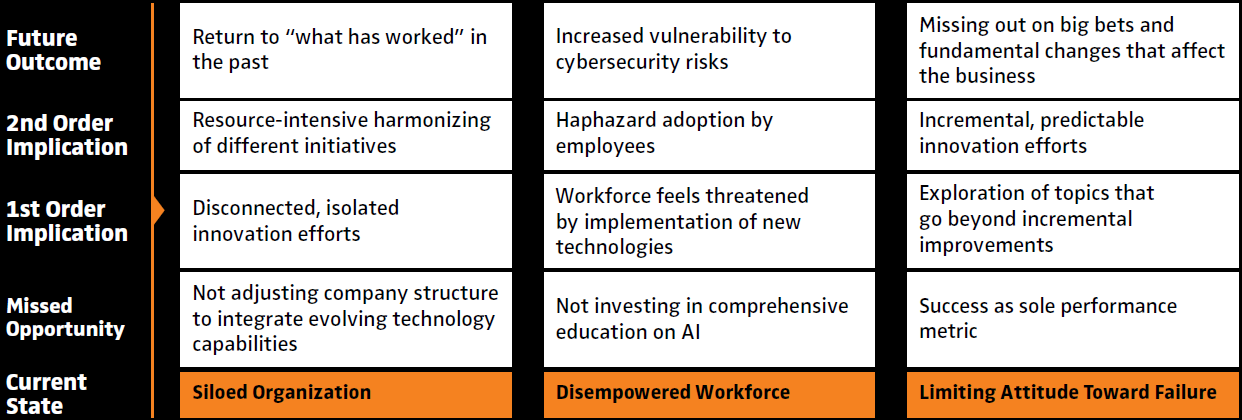
Technology

Now What?
Strategic Questions
Which stakeholders missing in my innovation ecosystem are keeping me from fully understanding opportunities for my business?
What resources are needed to prepare my company for a sensible integration of new technologies?
In what tangential areas could technology help me develop new products and services?
Am I sufficiently educated about and protected against new types of cyberthreats?
How could the adoption of environmentally friendly practices open up new growth avenues?
What ethical guidelines should my company adhere to as we navigate new partnerships along the supply chain?
How can I prepare my business for geopolitical escalation in Europe?
Is my company structure and culture conducive to leveraging the strengths of my employees?
What initiatives can be launched to enable more mothers and fathers to return to the workforce?
Key Themes for Business Leaders
While action has to come from all three stakeholders, business leaders are uniquely positioned to impact two spheres of influence: the economic as well as the societal sectors.
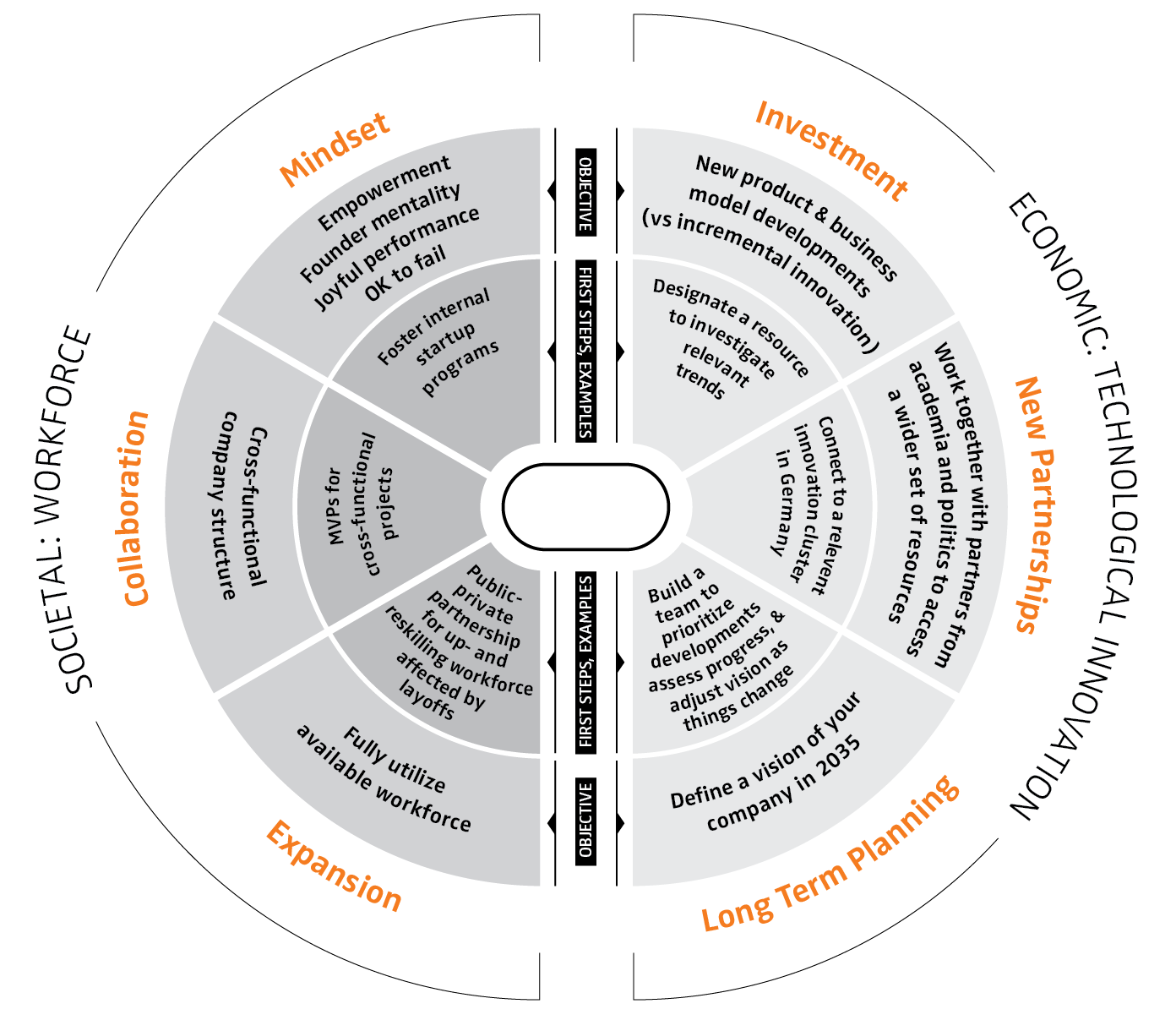
Appendix
Methodology
To develop the strategic scenarios in this report, our team conducted a series of 39 in-depth interviews with senior executives who are members of the Pulse Network. These executives come from various industries throughout Germany, and our discussions were structured to surface insights into the strategic challenges and opportunities they foresee in their sectors. We also captured a diverse range of perspectives on Germany’s government and business landscapes, ensuring our scenarios were grounded in real-world executive viewpoints.
To further refine our understanding, we conducted six intensive workshops designed to identify and evaluate the critical uncertainties that could significantly impact the future of Germany’s economy. Each workshop brought together a cross-functional mix of experts to collaboratively explore potential future states. Through this iterative process, we prototyped scenarios, rigorously challenging and validating each one against the backdrop of identified uncertainties.
In addition to interviews and workshops, our team conducted in-depth qualitative and quantitative research to identify signals of change, emerging trends, and macro forces influencing Germany’s future. Data sources included the following: patent and trademark filings, pre-print and published scientific papers, investment rounds, online search trends, macroeconomic data, government publications, news mentions and other sources. We used a proprietary system to identify patterns, which were then grouped into nodes and evaluated using a set of standardized indicators. Qualified trends were further scored for their trajectory, momentum and timing.
Scenarios were developed using our proprietary modeling process, which required many rounds of research, analysis and writing, followed by strategic discussions, to ensure that the most plausible futures were imagined, along with actionable insights and recommendations.
While some types of scenarios predict the future, these scenarios are intended to reduce uncertainty so that better decisions can be made in the present. This report is a strategic tool, designed to catalyze “what if” conversations within your organization and to help your leaders rehearse the future.
Thanking Our Contributors
The scenarios would not have come to fruition without the substantial expertise and support provided by numerous individuals. We owe a profound debt of gratitude to all of them for their essential contributions and their significant impact on the development of this research, among others:
- Alexander Weihe, Head of Innovation & Business Building, Vonovia
- Andreas Ronken, Ritter Sport, Chief Executive Officer, Alfred Ritter GmbH & Co KG
- Antje Leminsky, Member of the Executive Board, Bechtle
- Ariane Reinhart, Member of the Executive Board Group Human Relations and Sustainability, Continental
- Dr. Astrid Arndt, Chief People Officer, Zalando
- Christina Sontheim-Leven, Executive Board Member, Chief Human Resource Officer, CEWE Stiftung & Co. KGaA
- Claudia Nemat, Executive Board Member Technology & Innovation, Deutsche Telekom
- Constanze Hufenbecher, Member of the Shareholders Committee, Member of the Supervisory Board, Audit Committee Chair, Voith Group
- Dirk Ramhorst, Elisabeth Staudinger, Managing Board Member, Siemens Healthineers
- Heike Eckert, Member of the Executive Board, Deutsche Börse
- Heike Freund, Chief Operating Officer, Marvel Fusion
- Dr. Karin Exner-Wöhrer, Chief Executive Officer, Salzburger Aluminium Group
- Karolin Schriever, Executive Board Member, Deutscher Sparkassen- und Giroverband
- Katherina Reiche, Vorsitzende des Vorstandes, Westenergie AG
- Kristin Seyboth, Member of the Board, Bausparkasse Schwäbisch Hall AG
Rouven Acquaviva, Head of Corporate Strategy & Innovation , FUCHS Group - Prof. Dr. Sabina Jeschke, Chief Executive Officer, KI Park e.V.
- Sarena Lin, Siemens Healthineers, Non Executive Director, Member of The Supervisory Board
- Dr. Silke Maurer, Member of the Executive Board and Chief Operating Officer, MTU Aero Engines
- Simone Menne, President of the American Chamber of Commerce Germany, Supervisory Board Member and Chairwoman of the Audit Committee, Henkel
- Susan-Stefanie Breitkopf, Member of the Executive Board of the ZEISS Group and Chief Transformation Officer
- Tanja Dreilich, Chief Financial Officer, Hamburger Hafen und Logistiks AG
- Tatjana Kiel, Chief Executive Officer, Klitschko Ventures
- Ute Gerbaulet, Chief Financial Officer, Oetker-Gruppe
- Valentina Daiber, Executive Board Member, Legal and Corporate Affairs, Telefónica Germany
Work with Us
Future Today Institute has devised a series of next steps to advise business leaders on how the different futures for Germany will impact their business, and how they can build resilience in light of disruptive change.
Contact us at [email protected] for more information.
